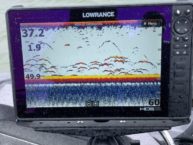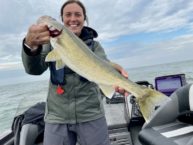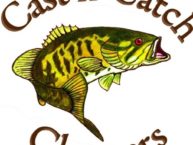Leadsled Crank Baits by contributing author Kirt Hedquist NPAA #292
When most people hear Leadsled they think of a custom low riding car, well fishing has its own Leadsled, low riding crankbaits trolled behind a boat on leadcore line getting down to where the fish are!
Trolling for me has become a huge factor in my fishing arsenal. At one time I was strictly a Lindy rigger, unless I had a hunk of meat on a hook I didn’t feel comfortable. Fishing various bodies of waters has forced me to learn other tactics including trolling and trolling with leadcore in particular. I would like to share with you some of the details that I have learned to help you shorten your learning curve. You can troll any kind of crankbait on leadcore; stick baits, shad style baits, deep diving stick baits or shallow style baits, in any kind of water, lakes and rivers, big and small.
The key components are the rod, reel and line, the rods I prefer are a 10’6” and a “shorty” in the 5’ length giving me a nice spread, the rod needs to have some give, not a buggy whip but a rod with some shock absorbency and back bone because lead core does not have any stretch to it, Dean Marshall from Deans Tackle Box www.deanstacklebox.com/ has introduced recently a series of leadcore trolling rods that are excellent for this presentation . Leadcore line is a long thread of lead wire coated with a Dacron covering for strength, it is color coded every 10 yards these color changes show the angler how much line is deployed. It comes in several weights, but 18# test is the most popular for walleye trolling because it has the smallest diameter-to-weight ratio of the available lines. Reels used for leadcore can be either baitcaster or line counter type reels and sized large enough to take all 10 colors of leadcore line, a smaller reel can be used which holds typically 6 colors. I prefer a larger line counter reel that holds 10 colors, it gives me the flexibility to fish deeper if needed and line counter reels, which gives me more accuracy when letting line out The other component is the leader, I prefer to use a braided superline such as Berkley Fireline Crystal with a crosslock snap and a uniknot to connect the Fireline to the leadcore. Push back the Dacron covering to expose about 10” of the leadcore, pinch it off and use this tag end to tie the uniknot. The reason I choose a superbraid is the no-stretch factor and can telegraph back to the rod tip what the crank bait is doing, such as fouling with weeds or skipping across the bottom, helping me to find the perfect position when setting the lure. Mono or Flourocarbon line could also be used for the leader material.
Also when trolling leadcore I utilize rod holders, this set up can get tiring to hold all day and I typically do not impart any extra action by pumping the rod back and forth, if the lure does get fouled I will rip it forward to remove any debri. My main propulsion source is a kicker engine, this allows me to fine tune my speeds and gives me the ability to go all day.
I also use a remote electric steer bow mount trolling motor to assist in boat control, remote electric steer will allow me to stand in the back of the boat while running the kicker. Some bow mount units such as the Minnkota Terrova employ a guidance system which will keep the boat on a set course, I can then focus my attention to getting the fish in the boat. Another use for the bow mount is following tight contours, it steers the bow faster allowing me to follow contours.
Now that I have covered the rod, reel, line and boat set up. Let’s talk about putting these Leadsled crankbaits in the water and start catching fish.
Leadcore line is speed dependent, speed up the shallower a crankbait will run, slow down and it runs deeper, due to the large diameter of the leadcore line and water resistance against it. This can be useful, if there is a hump, turn up the trolling speed, the leadcore then rises up and the crankbait clears the hump. There is no consistent dive curve, after some time on the water you will get a feel for this.
So what speeds do I typically run? I find myself in the 1.8 to 2.8 mph range, but here is where I let the fish tell me the speed that they prefer. One thing I watch for, it’s easy to let out too much line, the leadcore line itself will start dragging on the bottom, monitor rod tip for vibration indicating that the crankbait is running true. The “tune” of crankbait is critical, this will insure that it is running straight and true, if it blows out it will either tangle up with the other lines or not run at its optimal action and depth. To “tune” a crankbait, run it alongside the boat, give it a rip, whichever way it runs from center, bend the eyelet on crankbait slightly in the direction it needs to go, example: it is running to the left, bend the eyelet slightly right, and recheck it, it may take a couple of tries to get it correct, but it well worth the effort.
When I am picking a crankbait style to run, I look at water temps, forage base, time of year and weather conditions, I will lay out a selection of baits to get started, mix of colors, styles and sizes #4, #5 and #7 are what I will typically run. If I have the ability to run 4 rods, I run 4 different baits and I will let the fish tell me what they want, for example the Lindy Shadling come in a variety of colors and sizes, I will mix up colors and sizes.
I also set the drag on the loose side due to the low stretch factor of the line and the force at which the fish strike, there is risk of tearing the hooks out, this is where the shock absorbency of a good quality trolling rod is critical.
Ok, so lines are out crankbaits are doing their thing, FISH ON!!! I have the bowmount in the water keeping me on a steady course allowing me to focus on the fight, no need to set the hook, let them fight for a bit before grabbing the rod out of the holder which helps drive the hooks in and tire them out, lift the rod out the holder, no need to pump the rod, a steady and slow pace when reeling keeping the tip low to the water preventing the fish from skipping across the water and throwing the bait if the fish wants to run let them, don’t horse them in, the hooks will tear out, slide the fish into the net, simple as that.
And that’s how to get your crankbaits down to where the fish are, using the Leadsled CrankBait trolling method. This method helped me to win the 2009 FLW Walleye League Championship and I’m sure these tips will help you too!



